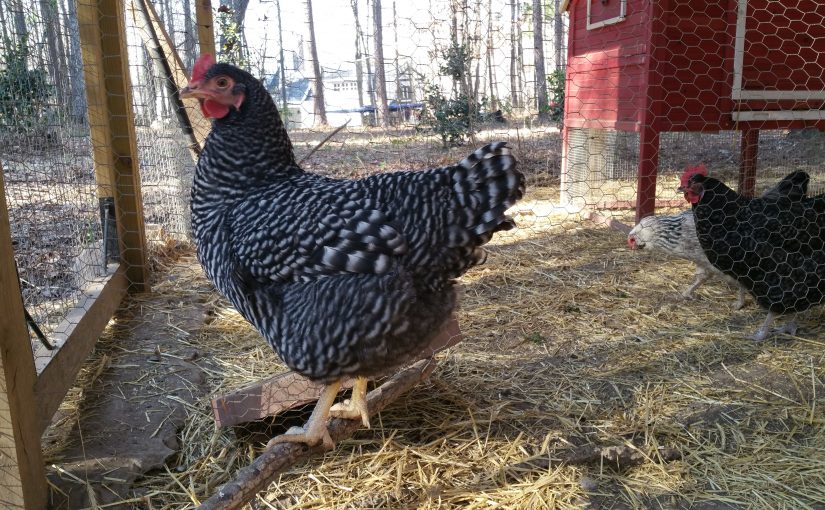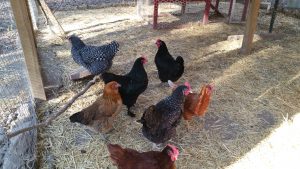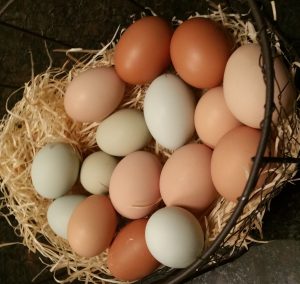Keeping chickens was not on any list of things I planned or hoped to do. I felt satisfied with my level of poultry-knowledge: “That is a chicken.” Sometimes, however, the road takes an unexpected turn and one may find oneself engaged in all sorts of uncharacteristic behaviors: applying Preparation H to a hen’s hindparts, spending the night in a barn, poking roosting possums with a garden rake in the dead of night, and taking a chicken to kindergarten. My road to chicken-keeping started with an innocent gift- and then one thing led to another.
Daughter 2 gave me a book- Margaret Floyd’s Eat Naked– and my ideas about food and stuff masquerading as food turned upside down. Appalled and enlightened, I purged pantry and refrigerator- and learned to cook all over again. My revamped, reformed, clean grocery list now included fresh, locally sourced, organic eggs from pastured hens. No problem- I found some just around the corner. A thirteen-year-old neighbor was an enterprising egg-merchant. I had my source, and she had a steady customer, until two unrelated events coincided and put her out of business: a fox got into her henhouse and she got a learner’s permit to drive. She had no more hens and no more interest. I had no more fresh eggs delivered to my door.
I considered that if a middle-schooler could oversee a chicken operation, I could, too. I researched chickens and began the task of convincing a skeptical husband that we needed laying hens and they would make me happy. By and by Husband and Son built a pen, Son-in-law 2 constructed a chicken house, Daughter 1 found a sketchy mountain woman who was willing to part with four hens at a special city-slicker rate, and we were poultry farmers.
Although I had never touched a live chicken before I brought Violet, Victoria, Margaret, and Edith home, it wasn’t long before I was catching and cleaning up after them (chickens are messy critters), tucking them into bed each night, highlighting passages in chicken books, frequenting farm supply stores, and unblinkingly treating prolapsed vent. (If you don’t know, don’t ask). Unfortunately, the condition recurred and we ended up eating Margaret.
As shocking as eating Margaret may sound, Margaret’s homegoing was mercifully quick and not nearly as traumatic as what happened to Octavia. Over time, we doubled the size of the pen and added to the flock (chickens are like tattoos- or potato chips- you always want another one- or six). Except for Edith’s demise and a tragic incident involving an unlatched door and Pumpkin the terrier, things had gone fairly well- until the morning I found what was left of stunning, iridescent-plumed Octavia. Violet, the flock’s benevolent matriarch, was alive, but missing half her feathers.
According to Storey’s Guide to Raising Chickens, “Predators” chapter, evidence indicated a raccoon raid; and Storey warned that the perpetrator would return. I determined to stakeout the crime scene. I would spend the night in the barn with ninety-five pounds of tooth and muscle (Scout) and a remorseless killer (Pumpkin). We would be ready for trouble, when trouble came.
After dark, Ray set a humane trap, wished us good night and good luck, and hurried back to the house. I had a pillow, a blanket, and a LED flashlight with a strobe feature that could cause a stroke. Scout promptly ran into Ray’s trap and sprung it. Pumpkin wanted the fish inside and they growled at each other while I crouched between them with the flashlight, permanently stuck on strobe, vainly trying to reset the trap. Giving up, I searched the barn for a weapon; I chose my driver and my four-iron, and set the clubs by the door. Any good chicken farmer would do the same, I think.
In the barn, windows open to the strange noises of the night, I lay on a tiny cot. Scout and Pumpkin disagreed over who would sleep on an old car cover until Pumpkin, seeing he couldn’t win, jumped on the cot with me. Scout came over and licked my face with a foot-long tongue that had licked a lot of other things that day, and Pumpkin objected. My face was between a lot of teeth. Finally, I curled up with too few covers and too much Pumpkin, listening for a ruckus, while Scout cried and wanted to go home. So passed the long hours of the night.
In the pale gray light before sunrise, all was well in the coop. Shivering and exhausted, I called our vigil a success. My comrades and I headed back to the house, and that’s when the raccoon came for Roxanne. A few days later, in broad daylight, he ate sassy Victoria (or at least the part he wanted).
Ray chicken-wired the rafters. He set the trap every night, but Pumpkin viewed it as a handy cat food dispenser. Seasoned poultry farmers know that displaying a sprung trap, decorated with tufts of dog hair, is not an effective anti-predator strategy. Someone advised that voices on a radio fool animals into thinking that people are around, so I blared conservative talk radio from the barn around the clock. A month went by, with no more attacks. Aha! The raccoon was a democrat!
We were down three hens- and Beatrice hadn’t laid an egg in five weeks, she was so traumatized- (whether by the violent murders of her friends or the election-year politics she had been listening to for seven hundred twenty hours, it’s hard to say). Anyway, it was time to replenish the flock.
I like started pullets-self-sufficient “teenagers” that quickly mature- but they’re hard to find locally in midsummer. I had never raised chicks- talk of heat lamps, brooders, and pasty-vent seemed too intimidating; but after reading up on chick-raising, I decided to try. The grandchildren, my mother, and I headed to the farm supply.
To my surprise, a shipment of pullets had just arrived. I went to choose a few, leaving Mother and the children watching chicks. Although I no longer needed chicks, leaving without them wasn’t an option. My pullets crated, I came back to the chick box and caught six of the biggest, most active birds, having learned that chicken-raising can carry a high mortality rate. At the register I said, ” I need a bag of chick starter and a bag of shavings. I have four pullets and six chicks.” I turned to smile at my favorite six-year-old, who was holding something in her hands.
While I was picking out pullets, a kindly farmer had caught for her the chick she pointed out- the tiniest, most delicate, downy yellow baby in the box. “This is Penny,” she said, beaming.
“Make that seven chicks,” I told the cashier, with a feeling of dread in my heart.
The pullets went into the chicken pen. The chicks went on the back porch. They quickly outgrew the red tub that formerly housed an earthworm colony, and graduated to a kiddie pool filled with shavings and enclosed with a rigging of plastic garden fencing, crossbeams and clothespins. They were fun to watch for several weeks, but cleaning their quarters wasn’t fun; and when we returned from a day out to find escaped chicks (and their calling cards) all over the porch, we deemed them ready to try their luck in the chicken penitentiary.
Everyone lived in happy harmony- four hens, four pullets, seven thriving chicklets until… the massacre. I could have been playing NPR on the radio- the raccoon wasn’t a democrat after all. It had ripped through the chicken wire in the rafters, dispatched one of the pullets, and killed every single chick. I wept over Penny and cussed all the raccoons in the county. While I bore a bucket of remains to Poultry Memorial Gardens, Pumpkin discovered five raccoons under the barn, sleeping off breakfast and dreaming of seconds. (There were none).
Thankfully we somehow intercepted the subsequent possum invasion just in time, Son-in-law 1 hearing me yelling for help that night. And the five-foot rat snake got tangled in the netting between the roof and the rafters all by itself. Chicken keeping is a dangerous endeavor. Everybody likes chicken.
At the moment, we have a flock of twelve hens. They remind me of a crowd of middle school girls. Violet, Beatrice, and Francine are the “cool kids.” Ingrid is a big girl with low self esteem who has no idea how pretty she is. She sort of hangs out with the cool kids because she and Francine became friends before Francine climbed up the raccoon-emptied-rungs on the social ladder. Eleanor, Rosalynn, and Jacqueline have their own clique. Blanche and Delores are outsiders who “lay low” but roost together to stay warm. Cindy, Suzy, and Pepper started in the community as tiny chicks and will always be best friends. Francine minds everybody’s business. Pepper is shy. Violet is curious and likes to be petted. (She’s the one who went to kindergarten). All twelve of the clucky girls are funny, and beautiful, and busy. They have a combined I.Q. of about forty. I like to watch them carry on.
Who knew when my daughter handed me a book about clean food, Ray and I would end up doing strange things like eating quinoa and working for a bunch of chickens? Ray claims the fresh, locally sourced, organic eggs from pastured hens that we collect each day cost us about fifty dollars apiece. I disagree. They are priceless.




I love this story Debbie!!!
As a fellow chicken-keeper (currently on hiatus from keeping due to full time job and full time motherhood), I LOVE this story. Everything about it. I truly laughed out loud.
Great story! Keep up the story telling💚
You, my dear, make reading so enjoyable. What a gift. Loved it!
This is great! I was thinking now that we are out on acreage we might attempt it again. I’ll think twice about it now.